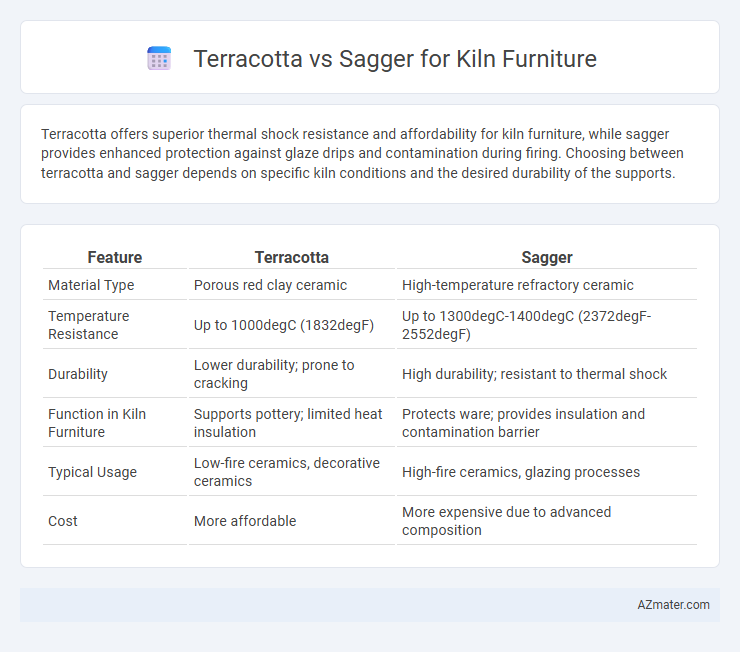Terracotta offers superior thermal shock resistance and affordability for kiln furniture, while sagger provides enhanced protection against glaze drips and contamination during firing. Choosing between terracotta and sagger depends on specific kiln conditions and the desired durability of the supports.
Table of Comparison
| Feature | Terracotta | Sagger |
|---|---|---|
| Material Type | Porous red clay ceramic | High-temperature refractory ceramic |
| Temperature Resistance | Up to 1000degC (1832degF) | Up to 1300degC-1400degC (2372degF-2552degF) |
| Durability | Lower durability; prone to cracking | High durability; resistant to thermal shock |
| Function in Kiln Furniture | Supports pottery; limited heat insulation | Protects ware; provides insulation and contamination barrier |
| Typical Usage | Low-fire ceramics, decorative ceramics | High-fire ceramics, glazing processes |
| Cost | More affordable | More expensive due to advanced composition |
Introduction to Kiln Furniture Materials
Terracotta and sagger are essential kiln furniture materials used to support ceramics during firing, each offering unique thermal properties and durability. Terracotta, a porous clay-based material, provides excellent thermal insulation but may have lower resistance to thermal shock compared to saggers, which are typically dense ceramic containers designed to protect ware from direct flames and contamination. Selecting between terracotta and sagger depends on factors like firing temperature, atmosphere, and the type of ceramic product being fired, ensuring optimal support and ceramic quality.
What is Terracotta?
Terracotta is a porous, clay-based ceramic material commonly used for kiln furniture due to its heat resistance and affordability. It withstands temperatures up to approximately 1000degC, making it ideal for supporting pottery during bisque firing. Its natural composition allows for efficient heat distribution while being more fragile compared to denser kiln furniture options like saggars.
What is Sagger?
Sagger is a protective container made from refractory clay used in kilns to shield ceramics from direct flame and ash during firing. It enhances the finish quality by preventing surface defects and contamination on delicate pottery and porcelain. Compared to terracotta, sagger offers superior heat resistance and structural durability under extreme kiln temperatures.
Key Properties of Terracotta
Terracotta used in kiln furniture offers excellent thermal insulation, high-temperature resistance up to 1200degC, and low thermal expansion, minimizing warping during firing. Its porous structure allows for vapor escape, reducing the risk of cracking and improving durability under repeated firing cycles. Compared to sagger materials, terracotta provides superior mechanical strength and heat retention, making it ideal for supporting ceramics in high-temperature kiln environments.
Key Properties of Sagger
Sagger, used in kiln furniture, exhibits excellent thermal resistance and chemical stability, making it ideal for protecting ceramics during firing. Its dense composition prevents contamination and deformation under high temperatures, ensuring product integrity. Compared to terracotta, sagger offers superior durability and maintains dimensional accuracy throughout repeated kiln cycles.
Durability: Terracotta vs Sagger
Terracotta kiln furniture offers moderate durability, often prone to cracking under high thermal stress, while sagger materials, typically made from refractory clay or firebrick, provide superior resistance to thermal shock and mechanical wear. Sagger's composition enables extended kiln lifespan and consistent protection for ceramic wares during firing cycles. Choosing saggars enhances kiln efficiency by minimizing breakage and maintenance compared to terracotta counterparts.
Heat Resistance Comparison
Terracotta kiln furniture typically withstands temperatures up to 1000degC, making it suitable for lower-temperature firings but less durable under intense heat. Sagger materials, often composed of high-alumina or porcelain clay, can endure temperatures exceeding 1300degC, offering superior heat resistance and longevity in high-temperature kiln environments. Choosing saggers ensures better thermal stability and reduces the risk of deformation during advanced firing processes.
Cost Efficiency and Availability
Terracotta kiln furniture offers significant cost efficiency due to its lower production expenses and widespread availability compared to sagger, which is made from more specialized refractory materials. The abundant supply of terracotta reduces lead times and bulk pricing advantages, making it ideal for large-scale or budget-conscious operations. Saggers provide superior durability and thermal resistance but come at a higher cost and typically require longer procurement times, impacting overall cost efficiency.
Typical Applications in Kiln Firing
Terracotta kiln furniture is commonly used for low-temperature firings such as ceramics and earthenware, offering excellent thermal insulation and cost-effectiveness. Saggers are typically employed in high-temperature firings, especially in the production of fine china and porcelain, where they protect ware from direct flame and impurities. Both materials enhance batch quality but differ in heat resistance and durability according to specific kiln firing applications.
Choosing the Right Kiln Furniture for Your Needs
Terracotta and sagger kiln furniture each offer unique benefits depending on your firing requirements, with terracotta providing excellent thermal insulation and cost-effectiveness, while saggers protect ceramics from direct flame and ash, ensuring a cleaner finish. When choosing the right kiln furniture, consider factors such as firing temperature, atmosphere, and the fragility of your work to determine whether the porous, heat-resistant nature of terracotta or the protective, refractory qualities of saggers best suit your needs. Selecting appropriate kiln furniture enhances firing efficiency, minimizes contamination, and protects your ceramics, ultimately improving the quality and durability of your finished pieces.

Infographic: Terracotta vs Sagger for Kiln Furniture
 azmater.com
azmater.com